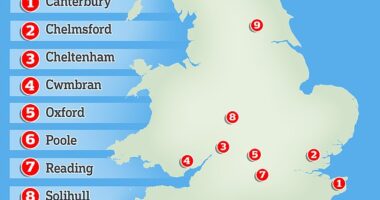RECORD numbers of new companies are being formed, but don’t let your retirement plans slide as you go solo in the workplace.
Millions of Brits have lost their jobs during the coronavirus pandemic and some have embraced their entrepreneurial side to start their own businesses.
Official data from Companies House shows a 29.4% quarterly increase in businesses setup in the final three months of 2020 to to 45,870.
It was the busiest quarter for company formations since 2012.
There are now 4.7m businesses on the UK companies register.
Becoming self-employed gives you more freedom to follow your passions and flexibility as you are your own boss.
There can be a downside though as leaving the employed space means you will no longer be saving into a pension.
Staff have been automatically-enrolled onto pension schemes since 2012 to get workers saving for their golden years.
When saving into a workplace pension, employers must contribute a minimum of 3% a month into an employee’s pension based on their earnings.
This is on top of the 5% an employee contributes to a pension scheme from their wages before tax.
What are the different types of pension?
WE round-up the main types of pension and how they differ:
- Personal pension or self-invested personal pension (Sipp) – This is probably the most flexible type of pension as you can choose your own provider and how much you invest.
- Workplace pension – The Government has made it so it’s compulsory for employers to automatically enrol you in your workplace pension, unless you choose to opt out. These so-called defined contribution (DC) pensions are usually chosen by your employer and you won’t be able to change it. Minimum contributions rose to 8% in April 2019, with employees now paying in 5% and employers contributing 3%. This is up from the 5% of contributions workers and companies were required to pay in previously, where employees contributed 3% and employers 2%.
- Final salary pension – This is a also a workplace pension but here, what you get in retirement is decided based on your salary, and you’ll be paid a set amount each year on retiring. It’s often referred to as a gold-plated pension or a defined benefit (DB) pension. But they’re not typically offered by employers anymore.
- New state pension – This is what the state pays to those who reach state pension age after April 6 2016. The maximum payout is £175.20 a week and you’ll need 35 years of national insurance contributions to get this. You also need at least ten years’ worth of national insurance contributions to qualify.
- Basic state pension – If you reached the state pension age on or before April 2016, you’ll get the basic state pension. The full amount is £134.25 per week and you’ll need 30 years of national insurance contributions to get this. If you have the basic state pension you may also get a top-up from what’s known as the additional or second state pension. Those who have built up national insurance contributions under both the basic and new state pensions will get a combination of both schemes.
But this doesn’t apply if you are self-employed or a freelancer.
You are on your own when it comes to pension savings if you work for yourself.
Just 31% of the self-employed contribute to a pension, according to the Money Advice Service, and even then it may be at relatively low levels.
Office for National Statistics data shows the number of people contributing to a pension increased to 10million in 2017, but it has remained flat among the self-employed.
You may not benefit from employer contributions, but that doesn’t mean you can’t put money away for your retirement.
Here is how to save into a pension if you are self-employed.
Personal pension
A self-employed person can still setup their own personal pension.
These are run by pension scheme providers such as Aviva and Zurich.
They will build and manage a portfolio of funds for you.
Usually an employer would help find a provider for you, but instead you will need to do this yourself or ask a financial adviser for help.
How pension tax relief works
SAVING into a pension can help boost your retirement income plus you also get a boost from the government in the form of tax relief.
All pension savers get tax relief on their contributions.
The government takes what you would have paid in income tax and puts it in your pension instead.
Basic rate taxpayers get a 20% boost and higher earners, those earning more than £50,000, get 40%.
Additional rate taxpayers, who earn more than £150,000, can get 45% relief.
You can search for financial advisers near you using VouchedFor.
An adviser may charge for their services and you should compare the management fees of the pension as well as where your money will be invested.
Alternatively, NEST (National Employment Savings Trust), which is the default automatic enrolment scheme setup by the government, also operates a product for the self-employed.
There are also online pension providers such as Penfold or PensionBee which will track down your retirement savings from previous workplace schemes and see if it is worth combining them into one pot.
Self-invested personal pension
Money-savvy savers can setup and manage their own pension.
This is known as a self invested personal pension (SIPP) and the product lets you choose your own funds and shares to invest in.
Unlike a personal pension, you are responsible for monitoring the performance and buying or selling new funds or shares if necessary.
You can setup a SIPP on investment platforms such as Hargreaves Lansdown, AJ Bell YouInvest and Interactive Investor.
Users will need to pay an annual platform fee where their SIPP is held as well as fund charges.
There may also be fees to buy and sell shares.
It is important to compare these costs as the charges can eat into your pension returns.
For example, Hargreaves Lansdown charges 0.45% to hold a SIPP containing funds worth up to £250,000 plus another 0.45% for shares.
A £15,000 investment in funds and £5,000 in shares would cost £7.50 a month or £90 a year.
In contrast, AJ Bell YouInvest charges 0.25% each to hold funds and shares.
The same investments would cost £4.16 per month or £50 a year on AJ Bell YouInvest.
This is before fund charges.
However, fund trades are free with Hargreaves Lansdown and cost £1.50 with AJ Bell YouInvest, so the costs could mount up if you are trading regularly.
It can cost up to £11.95 to trade shares on Hargreaves Lansdown compared with £9.95 on AJ Bell YouInvest.
Robo-wealth managers
There is a middle-ground between a personal pension and a SIPP.
Robo-wealth managers such as Raindrop, Nutmeg and Moneyfarm will build and manage a SIPP for you based on your attitude of risk.
Users need to complete an online questionnaire to assess their risk appetite and your money will be allocated into a portfolio of exchange traded funds based on your responses.
You can track the performance online and any portfolio changes will be done by the manager.
Fees and the choice of fund portfolios vary across different platforms.
Nutmeg charges 0.75% up to £100,000 and 0.35% beyond and also offers socially responsible portfolios.
In contrast, Moneyfarm charges 0.75% on the first £10,000, 0.6% between £10,000 an £50,000, 0.5% on £50,000 to £100,000 and 0.35% on anything over £100,000.
Fund fees are charged separately.
Websites such as Money To The Masses and Boring Money regularly review SIPP providers and can help you choose the most suitable one.
Now:Pensions has warned that 2.5million people are missing out on workplace pension benefits.
Retirees will get up to £230 extra a year in their state pension from April next year, the government has confirmed.
We’ve rounded up everything you need to know about when you can retire in the UK and how you can claim a state pension.


















